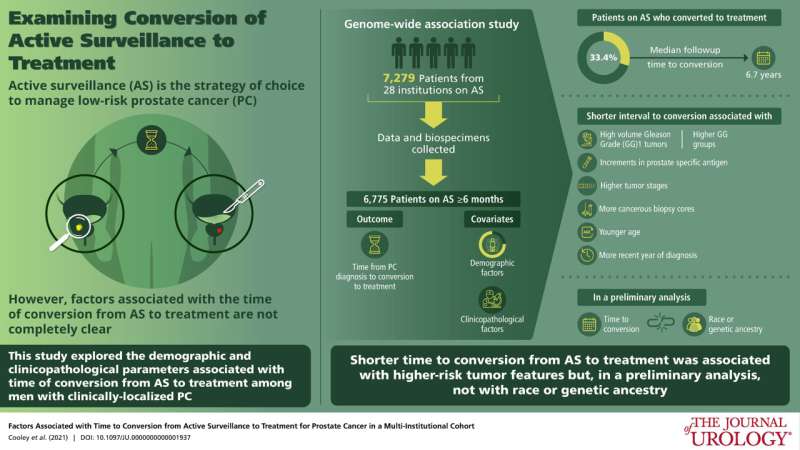Credit: Journal of Urology
For men with "low-risk" prostate cancer initially managed with active surveillance, cancer-related factors such as tumor grade and size are key risk factors for conversion to active treatment, reports a study in The Journal of Urology, an Official Journal of the American Urological Association (AUA).
Black men on active surveillance may not have shorter times to definitive treatment as previously reported from studies using Veterans Health Administration data. "Our study is the largest to assess the time to conversion from active surveillance to treatment for prostate cancer and provides new data on factors affecting the outcomes of this increasingly used management strategy," comments William J. Catalona, MD, of Northwestern University Feinberg School of Medicine, Chicago.
Findings may help predict outcomes of active surveillance
Active surveillance is used to monitor slow-growing, low-risk or localized prostate cancer rather than treating it straight away. It typically involves regular prostate-specific antigen (PSA) screenings, prostate exams, imaging studies, and repeat biopsies to carefully monitor prostate cancer misclassification, growth, or progression without compromising long-term outcomes. The aim of active surveillance is to avoid or delay unnecessary treatment and its side effects.
Active surveillance is increasingly viewed as the preferred approach for management of lower-risk prostate cancer. However, there is limited information on how long patients remain on active surveillance before converting to active or definitive treatment, such as surgery or radiation therapy.
Dr. Catalona and colleagues analyzed data on 6,775 patients with prostate cancer managed with active surveillance at 28 medical centers in a National Cancer Institute-sponsored Prostate SPORE (Specialized Program of Research Excellence) project (P50CA180995) study. Sixty-eight percent of the men were classified as having low-risk disease, based on factors including the Gleason grade, which assess the aggressiveness of cancer cell behavior; tumor stage, which reflects how far the cancer has spread; and the number of positive biopsy specimens (cores).
At a median follow-up time of 6.7 years, one-third of men had converted to active treatment. After adjustment for other factors, six cancer-related or clinical factors were independently related to shorter conversion times: higher Gleason grade, higher PSA level, higher tumor stage, and higher number of positive biopsy cores, more recent year of diagnosis, and younger age, confirming and expanding previous reports.
A preliminary analysis suggested that patients with high-volume, low Gleason grade tumors behaved more like high-risk patients than like low- or intermediate-risk patients, and the time to conversion was unrelated to the patients' self-reported race/ethnicity or to DNA markers of genetic ancestry. That's in contrast to some previous studies suggesting that Black men have more biologically aggressive prostate cancer and "may be managed with active surveillance less frequently in clinical practice," according to the authors. These preliminary findings and the association with the more recent year of diagnosis—reflecting recent, more liberal criteria for surveillance—are novel and require confirmation in other studies.
"Our study suggests that how long patients remain on active surveillance is affected mainly by higher-risk tumor factors," Dr. Catalona adds. "The findings will be helpful to physicians and patients as they discuss and make decisions about treatment options for low-risk prostate cancer."
More information: Lauren Folgosa Cooley et al, Factors Associated with Time to Conversion from Active Surveillance to Treatment for Prostate Cancer in a Multi-Institutional Cohort, Journal of Urology (2021). DOI: 10.1097/JU.0000000000001937
Journal information: Journal of Urology
Provided by Wolters Kluwer Health





















